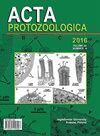基于形态、形态发生和分子系统发育的一种新的微咸水纤毛虫——新江乌兰虫(Ciliophora,Euplotida)的描述
IF 1.2
4区 生物学
Q4 MICROBIOLOGY
引用次数: 3
摘要
在中国新疆尉犁县的一条沟渠中发现了一种微咸水真拟虫纤毛虫,即新疆乌兰甲。根据体内检查的标本和鱼精蛋白染色,对其形态、纤毛虫和形态发生进行了研究。新物种的特征是由三个膜组成的崇拜区的后部,这在所有其他已知的同类中都从未见过。其他形态特征包括:(i)身体呈椭圆形,有明显的右前棘状突起;(ii)体内大小60-90×40-68μm;三两个大核结节;(iv)四个额侧、两个腹侧、五个横侧、三个左缘和三个尾侧卷须。它的形态发生以通常的方式进行,只是口腔原基在同源物中只形成三个近端膜,而不是四个近端壁。新物种的小亚基rRNA基因(GenBank登录号:KX147287)包含1723bp和44.63%的GC含量,与同源物种的差异为0.12–1.81%。基于SSU rRNA基因序列数据的系统发育分析表明,新疆乌兰甲在完全支持的情况下与其他乌兰甲物种集群,这支持了乌兰甲属的单系性,Stein,1859。本文章由计算机程序翻译,如有差异,请以英文原文为准。
Description of a new brackish water ciliate, Uronychia xinjiangensis n. sp. (Ciliophora, Euplotida) based on morphology, morphogenesis and molecular phylogeny
A brackish water euplotid ciliate, Uronychia xinjiangensis n. sp., was discovered in a ditch in Yuli County, Xinjiang, China. Its morphology, ciliature and morphogenesis were investigated based on specimens examined in vivo and following protargol staining. The new species is characterized by the posterior part of the adoral zone composed of three membranelles, which has never been seen in all other known congeners. Other morphologic features include: (i) body oval-shaped, with conspicuous right anterior spur-like protrusion;
(ii)size in vivo 60–90 × 40–68 μm; (iii) two macronuclear nodules; (iv) four frontal, two ventral, five transverse, three left marginal and three caudal cirri. Its morphogenesis proceeds in a usual way, except that the oral primordium forms only three proximal membranelles rather than four proximal membranelles within congeners. The small subunit rRNA gene of the new species (GenBank accession number: KX147287) comprises 1723 bp and 44.63% GC content, and differs by 0.12–1.81% from those of congeners. Phylogenetic analyses based on SSU rRNA gene sequence data reveal that Uronychia xinjiangensis n. sp. clusters with other Uronychia species with full support, which supports the monophyly of the genus Uronychia Stein, 1859.
求助全文
通过发布文献求助,成功后即可免费获取论文全文。
去求助
来源期刊

Acta Protozoologica
生物-微生物学
CiteScore
2.00
自引率
0.00%
发文量
8
审稿时长
>12 weeks
期刊介绍:
Acta Protozoologica - International Journal on Protistology - is a quarterly journal that publishes current and comprehensive, experimental, and theoretical contributions across the breadth of protistology, and cell biology of Eukaryote microorganisms including: behaviour, biochemistry and molecular biology, development, ecology, genetics, parasitology, physiology, photobiology, systematics and phylogeny, and ultrastructure. It publishes original research reports, critical reviews of current research written by invited experts in the field, short communications, book reviews, and letters to the Editor.
 求助内容:
求助内容: 应助结果提醒方式:
应助结果提醒方式:


